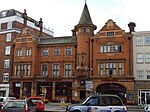Fulham Refuge
1856 establishments in England1888 disestablishments in EnglandDefunct prisons in LondonDemolished prisonsFormer buildings and structures in the London Borough of Hammersmith and Fulham ... and 5 more
Government buildings completed in 1856History of the London Borough of Hammersmith and FulhamInfrastructure completed in 1856Prisons in LondonWomen's prisons

Fulham Refuge, also known as Fulham Reformatory, was a women's prison in Fulham in west London that opened in 1856 and closed in 1888. The prison was intended to provide skills for prisoners to help rehabilitate them on their release back into the community.
Excerpt from the Wikipedia article Fulham Refuge (License: CC BY-SA 3.0, Authors, Images).Fulham Refuge
Buer Road, London Parson's Green (London Borough of Hammersmith and Fulham)
Geographical coordinates (GPS) Address Nearby Places Show on map
Geographical coordinates (GPS)
| Latitude | Longitude |
|---|---|
| N 51.47076 ° | E -0.20906 ° |
Address
Buer Road
Buer Road
SW6 4LA London, Parson's Green (London Borough of Hammersmith and Fulham)
England, United Kingdom
Open on Google Maps










